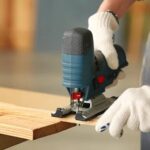Are you looking to give your woodwork a professional finish? If so, learning how to spray finish woodwork can be a game-changer. Spray finishing offers many benefits, including a smooth and even application, the ability to cover intricate details, and a faster drying time compared to traditional brushing or wiping techniques. In this article, we will guide you through the process of spray finishing your woodwork, from choosing the right equipment to troubleshooting common issues.
When it comes to spray finishing woodwork, one of the most crucial steps is choosing the right equipment. Different types of spray guns are available, each with their own advantages and applications. Along with the spray gun, there are other necessary tools such as respirators, protective gear, and materials for preparing and cleaning the woodwork before spraying.
Before you even think about picking up a spray gun, it’s important to prepare your woodwork properly. This involves sanding the surface to remove imperfections and ensuring that it is clean and free from dust and debris. The smoother the surface, the better the end result will be when you apply the finish. Understanding these initial steps will set you on the path towards achieving a professional-looking finish for your wood projects.
Choosing the Right Equipment
When it comes to spray finishing woodwork, choosing the right equipment is essential for achieving a professional and consistent finish. The type of spray gun you use can greatly impact the quality of the final result. There are several different types of spray guns available, each with its own unique features and advantages.
Here are some common types of spray guns used for finishing woodwork:
- Airless Spray Gun: This type of gun uses high pressure to atomize the coating, making it ideal for covering large surfaces quickly.
- HVLP (High Volume Low Pressure) Spray Gun: HVLP guns use low pressure to atomize the coating, resulting in less overspray and a softer finish.
- Compressed Air Spray Gun: These guns use compressed air to atomize the coating and are often more affordable than airless or HVLP options.
In addition to choosing the right spray gun, there are other necessary tools and equipment required for successful spray finishing. Here’s a list of some essential items you’ll need:
- Respirator or Mask: Protect yourself from inhaling potentially harmful fumes and particles while spraying.
- Safety Glasses: Shield your eyes from overspray and potential splatters from the woodwork.
- Sandpaper and Sanding Block: Prepare the woodwork by sanding it smooth before applying the finish.
- Tack Cloth: Use this sticky cloth to remove any dust or debris from the surface before spraying.
- Drop Cloths or Plastic Sheeting: Protect your workspace from overspray and drips with proper covering.
By selecting the right type of spray gun and gathering all necessary tools, you can ensure that you’re well-prepared for achieving a beautiful finish on your woodwork. In the next section, we’ll discuss how to properly prepare your woodwork before spraying.
Preparing the Woodwork
Sanding and cleaning the woodwork are crucial steps in preparing for a successful spray finish. Here are some tips on how to effectively prepare the woodwork before applying the finish:
1. Sanding: Start by using coarse-grit sandpaper to remove any rough spots, old finishes, or imperfections from the surface of the wood. Gradually move to finer grits to achieve a smooth and even surface. Make sure to sand in the direction of the wood grain to avoid leaving visible scratches.
2. Cleaning: After sanding, it’s important to thoroughly clean the woodwork to remove any dust, dirt, or debris that may have accumulated. Use a tack cloth or a vacuum with a brush attachment to ensure that the surface is completely clean before applying the finish.
3. Ensuring a Smooth Surface: Before proceeding with spraying, inspect the woodwork for any remaining blemishes or imperfections. Fill any cracks, holes, or gaps with an appropriate wood filler and sand it down once dry to create a uniform and smooth surface for the finish.
By following these steps, you can ensure that your woodwork is properly prepared for spray finishing. Proper preparation will not only result in a more professional-looking finish, but it will also help the finish adhere better and last longer.
Remember that proper preparation is key when using spray finishing techniques on woodwork. A poorly prepared surface can result in an uneven finish or adhesion issues that may require stripping and starting over from scratch.
Selecting the Right Finish
When it comes to spray finishing woodwork, one of the most important decisions you will make is choosing the right finish. The finish you select will not only affect the appearance of the wood, but also its durability and maintenance requirements. There are several different types of finishes available, each with its own unique properties and applications.
One popular option for finishing woodwork is polyurethane. This finish is known for its durability and water resistance, making it a great choice for items that will see a lot of use, such as tabletops or cabinets.
Another common type of finish is lacquer, which dries quickly and can be easily re-coated if needed. For a more natural look, you may opt for an oil finish such as tung oil or linseed oil, which penetrates into the wood to enhance its natural beauty.
Before choosing a finish, consider how the woodwork will be used and what kind of look you want to achieve. Additionally, keep in mind that some finishes may require more maintenance than others. For example, oil finishes may need to be reapplied periodically to maintain their appearance, while polyurethane provides long-lasting protection with minimal upkeep.
Finally, take into account the application method when selecting a finish. Some finishes are better suited for spraying than others. For example, lacquer is often applied with a spray gun to achieve a smooth and even coat. Understanding the characteristics and uses of different finishes will help you make an informed decision when selecting the right finish for your woodwork.
| Types of Finish | Properties |
|---|---|
| Polyurethane | Durable, water-resistant |
| Lacquer | Dries quickly, easy re-coating |
| Oil Finish (e.g. tung oil or linseed oil) | Natural look, needs periodic reapplication |
Setting Up Your Workspace
Before you start spray finishing your woodwork, it’s important to set up a workspace that is safe and efficient. Properly preparing your workspace will not only ensure the best results but also minimize any potential hazards. Here are some essential steps to consider when creating your spray finishing area.
First, choose a well-ventilated area to work in, preferably outdoors or in a well-ventilated garage. Adequate ventilation is crucial when spray finishing woodwork, as it helps to dissipate fumes and minimize the risk of inhalation. If working indoors, consider using exhaust fans and open windows to improve ventilation.
Next, protect your workspace by covering surfaces with drop cloths or plastic sheeting. This will prevent overspray from settling on unwanted areas and make cleanup easier. Additionally, consider setting up a designated spray booth using portable spray booth kits, which provide containment and filtration for a safer spraying environment.
Lastly, ensure that your workspace is free from any potential fire hazards. Keep flammable materials and sources of ignition away from the spraying area. It’s also important to have fire extinguishers readily available in case of emergencies.
Properly preparing your workspace for spray finishing woodwork is crucial for achieving professional results while keeping yourself and the environment safe. By following these steps, you can create an ideal environment for applying finishes to your woodwork projects while minimizing any potential risks or hazards.
| Workspace Considerations | Details |
|---|---|
| Ventilation | Choose a well-ventilated area or use exhaust fans for indoor work |
| Surface Protection | Cover surfaces with drop cloths or use portable spray booth kits for containment |
| Fire Safety | Keep flammable materials away and have fire extinguishers on hand |
Techniques for Spraying
Adjusting the Spray Gun
One of the key techniques in achieving a professional finish when spray finishing woodwork is properly adjusting the spray gun. The first step is ensuring that the air pressure and fluid flow are set to the manufacturer’s recommended specifications for the type of finish being used.
Additionally, properly adjusting the spray pattern to match the size and shape of the workpiece is essential for even coverage and a smooth finish. Practice with test pieces before starting on your woodwork to get a feel for how the spray gun operates and how to adjust it for different effects.
Proper Technique
Using proper spraying technique is crucial for achieving a professional finish on your woodwork. Holding the spray gun at a consistent distance from the surface, typically 6-8 inches, and moving your arm smoothly across the workpiece will help to avoid uneven coverage or drips.
Overlapping each pass by 50% ensures that every part of the woodwork receives an even coat of finish. It’s also important to keep the spray gun in motion while spraying, as holding it in one spot can cause over-application and potential runs in the finish.
Avoiding Overspray
Overspray occurs when more paint lands on a surface than is necessary, leading to wasted material and potential issues with drying or adhesion. To avoid overspray when spray finishing woodwork, make sure to practice good control with the spray gun and use masking tape or shields to protect any areas that should not receive finish.
Additionally, controlling ventilation in your workspace can help prevent overspray from spreading onto other surfaces and causing unwanted buildup. By paying attention to these details and practicing good technique, you can achieve a professional-quality finish on all your woodwork projects using a spray gun.
Safety Precautions
Protective Gear
When it comes to spray finishing woodwork, safety should always be a top priority. The first step in protecting yourself is to wear the appropriate protective gear. This includes a respirator to protect your lungs from inhaling harmful fumes, as well as gloves and goggles to prevent skin and eye irritation. Additionally, it’s important to work in a well-ventilated area or invest in a proper ventilation system to remove overspray and maintain air quality.
Environmental Considerations
In addition to protecting yourself, it’s also essential to consider the impact of spray finishing on the environment. Choose finishes that are low in volatile organic compounds (VOCs) to minimize air pollution and reduce health risks for both you and those around you.
If possible, opt for water-based finishes over solvent-based ones, as they are more eco-friendly. Properly dispose of any leftover finish or solvents according to local regulations, and consider investing in a paint booth or other containment system to prevent overspray from contaminating the surrounding area.
Fire Safety
Another important aspect of safety when spray finishing woodwork is fire prevention. Many finishing products are flammable, so it’s crucial to take precautions to avoid potential fires or explosions. Keep all sources of ignition, such as open flames or electrical equipment, away from the spraying area. Store flammable finishes and solvents in designated fireproof cabinets and never use them near heat sources. Finally, have a fire extinguisher readily available in case of emergency.
By following these safety precautions, you can protect both yourself and the environment while achieving professional results when spray finishing your woodwork.
Troubleshooting Common Issues
If you encounter drips, uneven coverage, or other issues while spray finishing woodwork, there are some troubleshooting tips to help you achieve a professional-looking finish. Drips can occur when too much finish is applied in one area, causing it to run down the surface.
To avoid drips, make sure to apply thin and even coats, holding the spray gun at the proper distance from the woodwork. If drips do occur, you can carefully sand them out once the finish has dried before applying another coat.
Uneven coverage is another common problem when spray finishing woodwork. This can happen if the spray gun is held too close to the surface, resulting in heavy buildup of finish in some areas and lighter coverage in others. To achieve an even coverage, practice your spraying technique on a scrap piece of wood before applying it to your project. Make sure to keep the gun moving at a consistent speed and distance from the surface.
In addition to drips and uneven coverage, other common issues may arise while spray finishing woodwork. These can include air bubbles in the finish, dust or debris getting into the surface, or orange peel texture. By understanding how to identify and address these issues, you can troubleshoot effectively and achieve professional results. Following best practices for equipment maintenance, technique refinement, and workspace preparation will also help prevent these problems from occurring in the first place.
By understanding how to troubleshoot common issues when spray finishing woodwork, you can overcome challenges that may arise during the process. With patience, practice, and attention to detail, you can achieve a smooth and professional finish on your woodwork projects that will showcase your craftsmanship and attention to detail.
Conclusion
In conclusion, learning how to spray finish woodwork can significantly enhance the quality and appearance of your projects. By understanding the benefits of spray finishing, choosing the right equipment, preparing the woodwork properly, selecting the right finish, setting up a safe workspace, and employing effective spraying techniques, you can achieve professional-looking results.
It is important to remember that practice makes perfect when it comes to spray finishing woodwork. The more you familiarize yourself with the process and experiment with different techniques, the better your results will be. Don’t be discouraged by initial challenges or imperfections – troubleshooting common issues and adjusting your approach will ultimately lead to success.
I encourage readers to take what they have learned from this guide and apply it to their own woodworking projects. Whether you are a beginner or an experienced woodworker, embracing spray finishing techniques can elevate the overall craftsmanship of your work. With patience, practice, and attention to detail, you can achieve stunning finishes that showcase the beauty of the wood and leave a lasting impression.
Frequently Asked Questions
Is It Better to Spray or Brush Wood Finish?
The choice between spraying or brushing wood finish depends on the specific project and personal preference. Spraying can often give a smoother, more even finish, while brushing allows for more control and precision in detailed areas.
Can You Apply Polyurethane With a Sprayer?
Yes, polyurethane can be applied with a sprayer. However, it’s important to use the appropriate type of sprayer and properly thin the polyurethane for optimal results. It’s also crucial to follow safety precautions when using a sprayer.
How Do You Get a Smooth Finish With Spray Lacquer?
Achieving a smooth finish with spray lacquer requires proper preparation, including sanding the wood to a smooth surface and applying thin, even coats of lacquer. It’s important to work in a well-ventilated area and allow for proper drying between coats.

Hi everyone! I’m a woodworker and blogger, and this is my woodworking blog. In my blog, I share tips and tricks for woodworkers of all skill levels, as well as project ideas that you can try yourself.





